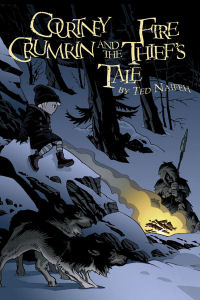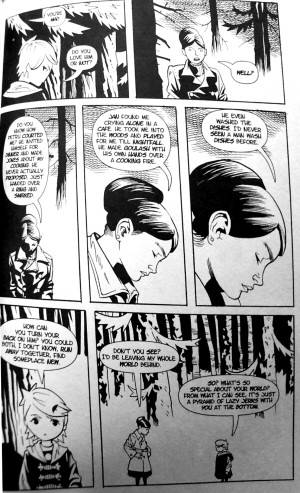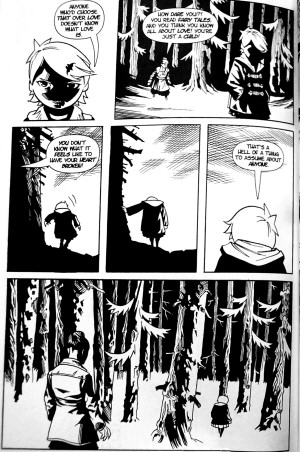This is the first in what I hope will be a series of positive posts about things that are great. It seems like I should balance out all my ranting in some way, and this seems like a good way.
 This time out I want to talk about Courtney Crumrin and the Fire-Thief’s Tale. I read a lot of comics every week, and this is clearly the stand-out best thing from the last couple of weeks. I’ve seen a lot of press for several other good and deserving books that came out in the period, but not a lot about this, and that makes me sad because it is so good.
This time out I want to talk about Courtney Crumrin and the Fire-Thief’s Tale. I read a lot of comics every week, and this is clearly the stand-out best thing from the last couple of weeks. I’ve seen a lot of press for several other good and deserving books that came out in the period, but not a lot about this, and that makes me sad because it is so good.
Depending on how you count, this is either the fourth or fifth book in the Courtney Crumrin series. The books are the work of Ted Naifeh. (See also his page at one of his publishers, his LiveJournal, and his Wikipedia entry.)
It would be very easy to mistake the Courtney series as “cute-Goth” books for young girls who want to think their social stigmata makes them superior to those that stigmatise them. They do have some of the surface characteristics of that type of work, but there’s a lot more going on under the surface here. The series focuses a lot more on questions of responsibility and sacrifice, the nature of love and repression, and the costs of emotional defenses than it does on issues like “fitting in”. Well, OK, the first book in the series touches on the “fitting in” stuff, but in a very, very non-sugary way. And, the series tackles the things it does with out being preachy or moralizing–the points are made implicitly, and the whole thing is delivered with a beautifully cynical panache and occasionally cutting wit.
I could write a kind of summary of the previous books in the series, in an attempt to illustrate why I’ve enjoyed it and how the books have gotten successively higher in quality… but that’s already been done at the late, lamented Ninth Art. If you’re not familiar with the series, you should check it out.
Here’s an extract:
Since premiering in 2001, Courtney’s oval, nose-less face has scowled its way through three increasingly dark, increasingly entertaining mini-series from Oni Press, abetted by the Herculean talents of her creator, Ted Naifeh. The result is some of the most wicked (and wickedly funny) fantasy comics of the last several years, the sort of stuff that can have you shivering in your seat on one page and cackling evilly on the next. Like Dahl’s best work, it has a dead-on understanding of a child’s point of view… and also understands that magic and wonder are not the kind of things that you can use without a price.
Each book in the series is better crafted than the preceding one as well as being “increasingly entertaining”, but with this latest book Naifeh has really stepped up. I wish the Ninth Art guys were still writing, just to see what they would say about it. There are some sequences in this book that hit me like a hammer, and some images that are still lingering with me weeks later.
I said there wasn’t much press or buzz on the book, but there was the obligatory Newsarama mini-interview, which gives me the chance to let Naifeh give the elevator pitch for this latest book in his own words:
NRAMA: Ted, not much has been said about what exactly Courtney Crumrin & The Fire Thief’s Tale is about, so can you tell us?
TN: Fire Thief’s Tale is about Courtney and Aloysius traveling through Europe, encountering old-world legends. I wanted to do a slightly different take on the classic monsters, so Fire Thief’s Tale has werewolves, and the next book after that will be about vampires. As a kid, I loved hearing ghost stories around the campfire, and reading old vampire legends from Eastern Europe. By the eighties, vampires weren’t scary anymore, they were hokey villains in teen comedies like Fright Night. For the Courtney books, I want to edge away from the hokeyness and evoke more the feeling of old-world campfire tales; timeless, bone-chilling stories that don’t rely on gore and monster effects. But I also want to address what these stories symbolized, and re-evaluate it in the light of modern thinking. After all, both vampires and werewolves were based on sexual repression, so I decided to make both Fire Thief’s Tale and its sequel, The Prince of Nowhere, love stories.
I don’t really want to talk about the plot of the book, but the plot is hardly the point. The point is a look at questions about power dynamics between and within societies, about the prices that must be paid for certain decisions, about what people are willing to sacrifice for love or what they call love, and about what kind of obstacles might just be insurmountable. For most of the book this is drawn as a conflict between Courtney’s possibly simplistic, and definitely romantic (scratch a cynic…) ideals and ways that the adults around her fail to live up to them… and then comes the ending. Boom.
I’m probably cheating the book by not talking much about the visuals–Naifeh uses a very clean line, and a style that varies (as you will see below) from a minimalist realism to almost cartoony. The level of detail varies substantially from panel to panel, but not because Naifeh is being slipshod–quit the opposite, he uses the additional detail and the shifts from the more cartoony to the more representational as a kind of cue for controlling our attention, and managing the flow of the narrative. He’s not afraid to make use of his blacks to create shadow and manipulate mood. The lines are clean and spare, and the storytelling is always clear. The character designs are interesting, with almost every adult in the book appearing slightly (or occasionally more than slightly) monstrous, something that’s probably a conscious choice reflecting Courtney’s perception of adults as slightly malign and dangerous. Indeed it sometimes seems that the only adults who don’t have that slightly monstrous look to them are the ones that Courtney has dismissed–her parents being a prime example from earlier books, or Magda in the current volume. Even our gypsy werewolf loverboy in this book take on more representational appearance once Courtney has cast him as a sympathetic character in her worldview, a slight change from the more abstract and feral designs he appears with early on.
I do kind of wish Naifeh would take the time to draw hands, though. While his clawlike sketches work fairly well with the whole “abstract and slightly monstrous” design, I think I’d rather see hands. See the last panel in the samples below to see what I mean.
I’m really looking forward to seeing what Naifeh does with the ongoing meta-story of Courtney’s education, and its effect on her worldview. There’s a chance that the series could end being something of a coming of age tragedy, if Courtney adopts all of her Uncle’s views, and a chance that it could be a little sugary if she somehow manages to hold on to some of her ideals despite what she sees. My money, though, is on a much more complex and nuanced resolution that falls somewhere in between–and that’s what I can’t wait for.
Just go read it. Read the whole series–it’s all in print, available at better comic stores and online. Hell, your local library might have it. Your life will be better for having done so. I guarantee it.
Here’s an excerpt from the book, one of my favourite sequences. Forgive the crappy nature of the images–I didn’t want to mutilate the book in order to get flat scans, so you’re looking at images from digital camera snapshots. The three-panel series in the middle of the second page shown is one of the best things I’ve seen in comics–it’s stayed with me since I read the book. It’s the perfect illustration of how Naifeh can hit an emotional beat perfectly with the things not said carrying all the weight, and the very simple, clean illustration utterly capturing details of posture, reaction, and pacing that do all the work of saying what’s not said:
I should also note that Naifeh’s done several other interesting projects, notably including his gender-bending goth lifestyle book, How Loathsome. That book shocked me a few times, by the way. Apparently my North Bay upbringing didn’t prepare me for things that might be taken for granted in the apparently somewhat liquid gender world of the city goth scene. At this point I’m pretty much a completist, and nothing has disappointed me yet.



